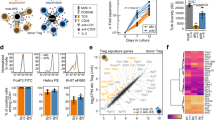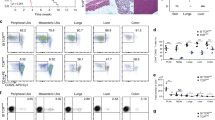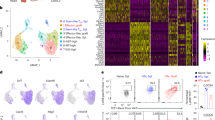Abstract
Alloreactive CD8+ T cells may persist in animals made tolerant of transplanted tissues; their function is controlled through continuous censorship by regulatory CD4+ T cells. We sought to establish the stage at which such censorship operates. We found that monospecific CD8+ T cells introduced into tolerant animals responded to the tolerated tissue antigen as if they had received CD4+ T cell “help”: they proliferated and accumulated normally. However, they did show compromised graft rejection, interferon-γ production and cell-mediated cytotoxicity. These findings suggest that tolerance mediated by regulatory T cells acts by censoring immune effector functions rather than by limiting the induction of T cell responses.
This is a preview of subscription content, access via your institution
Access options
Subscribe to this journal
Receive 12 print issues and online access
$209.00 per year
only $17.42 per issue
Buy this article
- Purchase on Springer Link
- Instant access to full article PDF
Prices may be subject to local taxes which are calculated during checkout





Similar content being viewed by others
References
Qin, S. et al. “Infectious” transplantation tolerance. Science 259, 974–977 (1993).
Onodera, K. et al. Induction of “infectious” tolerance to MHC-incompatible cardiac allografts in CD4 monoclonal antibody-treated sensitized rat recipients. J. Immunol. 157, 1944–1950 (1996).
Waldmann, H. & Cobbold, S. How do monoclonal antibodies induce tolerance? A role for infectious tolerance? Annu. Rev. Immunol. 16, 619–644 (1998).
Taylor, P.A., Noelle, R.J. & Blazar, B.R. CD4+CD25+ immune regulatory cells are required for induction of tolerance to alloantigen via costimulatory blockade. J. Exp. Med. 193, 1311–1318 (2001).
Kingsley, C.I., Karim, M., Bushell, A.R. & Wood, K.J. CD25+CD4+ regulatory T cells prevent graft rejection: CTLA-4- and IL-10-dependent immunoregulation of alloresponses. J. Immunol. 168, 1080–1086 (2002).
Graca, L. et al. Both CD4+CD25+ and CD4+CD25− regulatory cells mediate dominant transplantation tolerance. J. Immunol. 168, 5558–5565 (2002).
Fowell, D. & Mason, D. Evidence that the T cell repertoire of normal rats contains cells with the potential to cause diabetes. Characterization of the CD4+ T cell subset that inhibits this autoimmune potential. J. Exp. Med. 177, 627–636 (1993).
Sakaguchi, S., Sakaguchi, N., Asano, M., Itoh, M. & Toda, M. Immunologic self-tolerance maintained by activated T cells expressing IL-2 receptor α-chains (CD25). Breakdown of a single mechanism of self-tolerance causes various autoimmune diseases. J. Immunol. 155, 1151–1164 (1995).
Suri-Payer, E., Amar, A.Z., Thornton, A.M. & Shevach, E.M. CD4+CD25+ T cells inhibit both the induction and effector function of autoreactive T cells and represent a unique lineage of immunoregulatory cells. J. Immunol. 160, 1212–1218 (1998).
Marshall, S.E. et al. Tolerance and suppression in a primed immune system. Transplantation 62, 1614–1621 (1996).
Tran, H.M. et al. Distinct mechanisms for the induction and maintenance of allograft tolerance with CTLA4-Fc treatment. J. Immunol. 159, 2232–2239 (1997).
Takahashi, T. et al. Immunologic self-tolerance maintained by CD25+CD4+ naturally anergic and suppressive T cells: induction of autoimmune disease by breaking their anergic/suppressive state. Int. Immunol. 10, 1969–1980 (1998).
Piccirillo, C.A. & Shevach, E.M. Cutting edge: control of CD8+ T cell activation by CD4+CD25+ Immunoregulatory cells. J. Immunol. 167, 1137–1140 (2001).
Cantor, H. & Boyse, E.A. Functional subclasses of T lymphocytes bearing different Ly antigens. II. Cooperation between subclasses of Ly+ cells in the generation of killer activity. J. Exp. Med. 141, 1390–1399 (1975).
Bach, F.H., Bach, M.L. & Sondel, P.M. Differential function of major histocompatibility complex antigens in T-lymphocyte activation. Nature 259, 273–281 (1976).
Schoenberger, S.P., Toes, R.E., van der Voort, E.I., Offringa, R. & Melief, C.J. T-cell help for cytotoxic T lymphocytes is mediated by CD40-CD40L interactions. Nature 393, 480–483 (1998).
Ridge, J.P., Di Rosa, F. & Matzinger, P. A conditioned dendritic cell can be a temporal bridge between a CD4+ T-helper and a T-killer cell. Nature 393, 474–478 (1998).
Keene, J.A. & Forman, J. Helper activity is required for the in vivo generation of cytotoxic T lymphocytes. J. Exp. Med. 155, 768–782 (1982).
Waldmann, H. & Cobbold, S. Regulating the immune response to transplants. a role for CD4+ regulatory cells? Immunity 14, 399–406 (2001).
Schonrich, G. et al. Down-regulation of T cell receptors on self-reactive T cells as a novel mechanism for extrathymic tolerance induction. Cell 65, 293–304 (1991)
Hua, C., Boyer, C., Buferne, M. & Schmitt-Verhulst, A.M. Monoclonal antibodies against an H-2Kb-specific cytotoxic T cell clone detect several clone-specific molecules. J. Immunol. 136, 1937–1944 (1986).
Zelenika, D. et al. The role of CD4+ T cell subsets in determining transplantation rejection or tolerance. Immunol. Rev. 182, 164–179 (2001).
Li, Y. et al. Blocking both signal 1 and signal 2 of T-cell activation prevents apoptosis of alloreactive T cells and induction of peripheral allograft tolerance. Nature Med 5, 1298–1302 (1999).
Wells, A.D. et al. Requirement for T-cell apoptosis in the induction of peripheral transplantation tolerance. Nature Med 5, 1303–1307 (1999).
Kurts, C. et al. CD4+ T cell help impairs CD8+ T cell deletion induced by cross-presentation of self-antigens and favors autoimmunity. J. Exp. Med. 186, 2057–2062 (1997).
Thornton, A.M. & Shevach, E.M. CD4+CD25+ immunoregulatory T cells suppress polyclonal T cell activation in vitro by inhibiting interleukin 2 production. J. Exp. Med. 188, 287–296 (1998).
Polanski, M., Melican, N.S., Zhang, J. & Weiner, H.L. Oral administration of the immunodominant B-chain of insulin reduces diabetes in a co-transfer model of diabetes in the NOD mouse and is associated with a switch from Th1 to Th2 cytokines. J. Autoimmunity 10, 339–346 (1997).
Groux, H. et al. A CD4+ T-cell subset inhibits antigen-specific T-cell responses and prevents colitis. Nature 389, 737–742 (1997).
Hall, B.M. et al. Anti-CD4 monoclonal antibody-induced tolerance to MHC-incompatible cardiac allografts maintained by CD4+ suppressor T cells that are not dependent upon IL-4. J. Immunol. 161, 5147–5156 (1998).
Asseman, C., Mauze, S., Leach, M.W., Coffman, R.L. & Powrie, F. An essential role for interleukin 10 in the function of regulatory T cells that inhibit intestinal inflammation. J. Exp. Med. 190, 995–1004 (1999).
Seddon, B. & Mason, D. Regulatory T cells in the control of autoimmunity: the essential role of transforming growth factor β and interleukin 4 in the prevention of autoimmune thyroiditis in rats by peripheral CD4+CD45RC− cells and CD4+CD8− thymocytes. J. Exp. Med. 189, 279–288 (1999).
Bushell, A., Niimi, M., Morris, P.J. & Wood, K.J. Evidence for immune regulation in the induction of transplantation tolerance: a conditional but limited role for IL-4. J. Immunol. 162, 1359–1366 (1999).
Hara, M. et al. IL-10 is required for regulatory T cells to mediate tolerance to alloantigens in vivo. J. Immunol. 166, 3789–3796 (2001).
Zajac, A.J. et al. Viral immune evasion due to persistence of activated T cells without effector function. J. Exp. Med. 188, 2205–2213 (1998).
Appay, V. et al. HIV-specific CD8+ T cells produce antiviral cytokines but are impaired in cytolytic function. J. Exp. Med. 192, 63–75 (2000).
Thimme, R. et al. Determinants of viral clearance and persistence during acute hepatitis C virus infection. J. Exp. Med. 194, 1395–1406 (2001).
Lee, P.P. et al. Characterization of circulating T cells specific for tumor-associated antigens in melanoma patients. Nature Med. 5, 677–685 (1999).
Hernandez, J., Aung, S., Redmond, W.L. & Sherman, L.A. Phenotypic and functional analysis of CD8+ T cells undergoing peripheral deletion in response to cross-presentation of self-antigen. J. Exp. Med. 194, 707–718 (2001).
Kalams, S.A. & Walker, B.D. The critical need for CD4 help in maintaining effective cytotoxic T lymphocyte responses. J. Exp. Med. 188, 2199–2204 (1998).
Tarazona, R. et al. Effects of different antigenic microenvironments on the course of CD8+ T cell responses in vivo. Int. Immunol. 8, 351–358 (1996).
Zelenika, D. et al. Regulatory T cells overexpress a subset of Th2 gene transcripts. J. Immunol. 168, 1069–1079 (2002).
Monaco, A.P., Wood, M.L., Gray, J.G. & Russel, P.S. Studies on heterologous anti-lymphocyte serum in mice. II. Effect on the immune response. J. Immunol. 96, 229–232 (1966).
Billingham, R.E., Brent, L. & Medawar, P.B. Actively acquired tolerance to foreign cells. Nature 172, 603–606 (1953).
Qin, S.X. et al. Induction of tolerance in peripheral T cells with monoclonal antibodies. Eur. J. Immunol. 20, 2737–2745 (1990).
Cobbold, S.P., Jayasuriya, A., Nash, A., Prospero, T.D. & Waldmann, H. Therapy with monoclonal antibodies by elimination of T-cell subsets in vivo. Nature 312, 548–551 (1984).
Noelle, R.J. et al. A 39-kDa protein on activated helper T cells binds CD40 and transduces the signal for cognate activation of B cells. Proc. Natl. Acad. Sci. USA 89, 6550–6554 (1992).
Rolink, A., Melchers, F. & Andersson, J. The SCID but not the RAG-2 gene product is required for Sμ-Sε heavy chain class switching. Immunity 5, 319–330 (1996).
Jung, T., Schauer, U., Heusser, C., Neumann, C. & Rieger, C. Detection of intracellular cytokines by flow cytometry. J. Immunol. Meth. 159, 197–207 (1993).
Zelenika, D. et al. Rejection of H-Y disparate skin grafts by monospecific CD4+ Th1 and Th2 cells: no requirement for CD8+ T cells or B cells. J. Immunol. 161, 1868–1874 (1998).
Matzinger, P. The JAM test. A simple assay for DNA fragmentation and cell death. J. Immunol. Meth. 145, 185–192 (1991).
Acknowledgements
We thank S. Humm for preparing many of the mAbs used in vivo and the PSB staff—especially M. Coates, K. Steventon and S. Laynes. Supported by a program grant from the Medical Research Council, UK and the Chang-Gung Memorial Hospital, Taiwan (to C. L.).
Author information
Authors and Affiliations
Corresponding author
Ethics declarations
Competing interests
The authors declare no competing financial interests.
Supplementary information
Web Fig. 1.
Tolerance induction to fully mismatched skin allografts. CBA mice were treated with three doses of 1 mg of the anti-CD4, anti-CD8 and anti-CD154 nondepleting mAbs over 1 week following B10 skin transplantation at day 0. These mice accepted the allografts indefinitely as well as new B10 skin transplants grafted at day 100 (filled squares, n = 6, MST > 200 days). The same mice remained competent to reject third-party BALB/c skin grafts, transplanted at day 145 (open squares, n = 6, MST = 16 days). Mice treated with the same mAbs without an initial tolerising skin allograft, rejected B10 skin grafts when transplanted at day 100 (filled triangles, n = 5, MST = 16 days) as well as BALB/c grafts transplanted at day 145 (open triangles, n = 5, MST = 15 days). Untreated controls readily rejected B10 skin allografts (filled circles, n = 10, MST = 10 days). (PDF 114 kb)
Web Fig. 2.
An agonist CD40 mAb can bypass help for CD8+ T cell expansion. Euthymic or thymectomized and CD4-depleted CBA mice were injected intravenously with 1 × 107 CFSE-labeled Des+ CD8+ T cells. The following day, mice were immunized intravenously with 1 × 106 (CBA × B10)F1 APCs or no APCs as a control. In addition, some mice received agonist CD40 mAb (FGK-45, 1 mg per mice) by i.p. injection. (a) The average number of divisions was calculated by the equation listed in the Methods. (b) Total number of Des+ CD8+ T cells in spleens of host mice. Six mice were included in each group. Data were pooled from three independent experiments. (PDF 129 kb)
Rights and permissions
About this article
Cite this article
Lin, CY., Graca, L., Cobbold, S. et al. Dominant transplantation tolerance impairs CD8+ T cell function but not expansion. Nat Immunol 3, 1208–1213 (2002). https://doi.org/10.1038/ni853
Received:
Accepted:
Published:
Issue Date:
DOI: https://doi.org/10.1038/ni853
This article is cited by
-
The pursuit of transplantation tolerance: new mechanistic insights
Cellular & Molecular Immunology (2019)
-
Regulatory T cells from patients with end-stage organ disease can be isolated, expanded and cryopreserved according good manufacturing practice improving their function
Journal of Translational Medicine (2019)
-
Germline hypomorphic CARD11 mutations in severe atopic disease
Nature Genetics (2017)
-
The fate of CD4+ T cells under tolerance‐inducing stimulation: a modeling perspective
Immunology & Cell Biology (2013)
-
Tolerance: an overview and perspectives
Nature Reviews Nephrology (2010)



